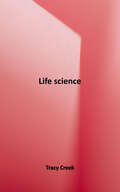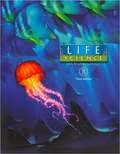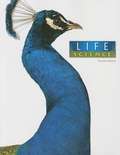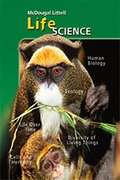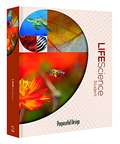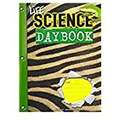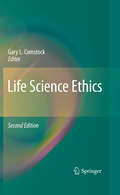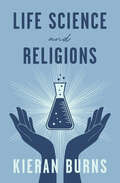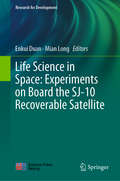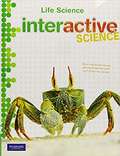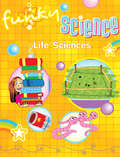- Table View
- List View
Life Science
by Tracy CreekLife Science addresses the changes in the study of biology in the 21st century and treats them at an appropriate middle-school level. This text is an essential for any student setting upon their study of science in today’s world.
Life Science (3rd Edition): Volume A
by Brad R. Batdorf Thomas E. PorchLIFE SCIENCE, 3rd ed., is a middle-school textbook written by people who believe the Bible is the Word of God. Those who do not believe that the Bible is true will find many points in this book puzzling. As we begin this course, let us define what the course is. Science can be defined as man's observations of the world God created and man's use of those observations to make decisions. Life science is observations and decisions about living things. In a life science course, you should learn about the observations other people have made of living things. You should also develop the skills necessary to make good observations on your own. Finally, in a Christian life science course, you should learn what God has said about life and living things. You should learn the principles He has given to direct our decision making about living things. God has given us senses that enable us to explore our world and minds to analyze our observations. Over the centuries, scientists have developed an organized process for making decisions about the world. This scientific method is a powerful and valuable tool, but like all tools it is hindered by human limitations and shortcomings.
Life Science (Grade #7)
by Mcdougal LittellFeatures in this book include life over time, diversity of living things, ecology and human biology.
Life Science - Student Edition
by Purposeful Design Publications Development TeamThis student textbook includes: worldview connections; critical thinking skills that are developed through scientific inquiry and investigation; hands-on learning activities that excite students to want to know more; the language and processes of science; tools to help students be responsible for understanding concepts and lesson objectives. It is designed to be used with the Life Science Lab Manual.
Life Science 2: What Is Going On Inside Me? (IQWST)
by Joseph Krajcik Brian ReiserNIMAC-sourced textbook
Life Science 7: Student Guide Part 1
by The Editors at the K12 Inc.Part 1 covers these units: Organisms, Cells, Living Systems along with Semester Assessments.
Life Science Daybook
by Great Source Education GroupThe units of this book explain Cells, Heredity, Diversity and Change, Living Things, Human Body Systems, and Ecology.
Life Science Ethics
by Gary L. ComstockDoes nature have intrinsic value? Should we be doing more to save wilderness and ocean ecosystems? What are our duties to future generations of humans? Do animals have rights? This revised edition of "Life Science Ethics" introduces these questions using narrative case studies on genetically modified foods, use of animals in research, nanotechnology, and global climate change, and then explores them in detail using essays written by nationally-recognized experts in the ethics field. Part I introduces ethics, the relationship of religion to ethics, how we assess ethical arguments, and a method ethicists use to reason about ethical theories. Part II demonstrates the relevance of ethical reasoning to the environment, land, farms, food, biotechnology, genetically modified foods, animals in agriculture and research, climate change, and nanotechnology. Part III presents case studies for the topics found in Part II.
Life Science Student Lab Manual
by Elizabeth A. Lacy Jeff S. FosterIncorporates activities into reading and learning the concepts discussed in class. This mainly involves lab manual applications and investigations.
Life Science and Religions
by Kieran BurnsAn investigation of life science and world religions, and how the two intersect. In Life Science and Religions, Kieran Burns uses Christianity&’s story of the fall of Adam and Eve and the curse of painful childbirth as a starting point to explore the relationship between religion and life science. Over the course of this study, Burns covers Buddhism, Christianity, Confucianism, Hinduism, Islam, Judaism, and Taoism. He discusses topics such as evolution, human suffering, and the notions of healing and perfection. He even looks at what science has to say about spiritual apparitions like Our Lady of Zeitoun, Our Lady of Guadalupe, and Our Lady of Lourdes. This thought-provoking study is sure to interest both students and armchair scholars.
Life Science for Christian Schools (Grade 7, 2nd Edition)
by David R. Anderson William S. Pinkston Jr.Life Science for Christian Schools is a middle-school textbook written for Bible-believing Christians. Those who do not believe that the Bible is the inspired, inerrant (in EHR unt) Word of God will find many points in this book puzzling. This book was not written with such people in mind.
Life Science for Middle School
by Barbara Ferrier Timothy Eimer Cheryl HoogewindThe following topics are covered in this curriculum: Life, Viruses, Bacteria, Protoctists, and Fungi, Plants, Animals, The Human Body, Genetics and Heredity, and Ecology.
Life Science in Space: Experiments on Board the SJ-10 Recoverable Satellite (Research for Development)
by Enkui Duan Mian LongThis book presents the life science experiments in a space microgravity environment conducted on board the SJ-10 recoverable satellite, which was launched on April 6th 2016 and recovered on April 18th 2016. It covers 10 scientific projects in radiation biology, gravitational biology and biotechnology that were selected from ~100 proposals from various institutions in China and around the world. Primarily exploring the rhythm of life in a space microgravity environment, all of the experiments – conducted on nine payloads of the SJ-10 satellite – have never been previously conducted in the respective fields. In addition, the book provides extensive information on the mission’s execution, data collection, and scientific outcomes.
Life Science: Book B
by Brad R. Batdorf Thomas E. PorchA thorough overview of the life sciences but now in two volumes with larger format and single-column text. Activity pages with color illustrations and photographs are included in back of student text. <P><P>Objectives are listed at the beginning of each section, and self quizzes are at the end of each chapter in addition to regular review questions. <P><P>There is increased emphasis on Bible integration as well as career features, increased compliance with national and state science standards, enhanced appendices on classification and biomes, and an expanded glossary and index
Life Science: Grade 4 (Scott Foresman Science, 2003)
by Scott ForesmanScott Foresman Science (2003) components for Grade 4.
Life Science: Guided Reading and Study Workbook (Science Explorer: Life, Earth And Physical Science #Student Edition)
by Prentice-Hall StaffScience Explorer Life Science Guided Study Worksheets Se 2001c
Life Science: Interactive Science, Grade 7
by Prentice-Hall Staff<p>Interactive Science: Grade 7 is the next step in your child's Science homeschool programs. All levels of Interactive Science include hands-on activities, exciting labs and engaging topics sure to help your child find enjoyment in learning. This curriculum for homeschooling is unlike any other in that it helps you design dynamic lessons that meet educational goals. <p>Using the materials included in Interactive Science: Grade 7, you'll be able to craft lessons that will solidify your child's foundational Science knowledge. The best part is that he or she is sure to find excitement in the journey! <p>Interactive Science is a flexible program that allows you to work at your child's pace and incorporate all the curriculum's more hands-on offerings. <p>Because your child is at the middle school level, he or she needs a challenging Science program. Interactive Science: Grade 7 simultaneously reiterates important foundational information and helps your child progress.
Life Sciences Funky Science (Funky Science)
by Kirsten HallSmart and savvy girls will love discovering the secrets of science! Funky Science: Life Sciences has loads of cool, creative experiments presented in a fun and accessible way, relating to topics that girls love. Check out all sorts of cool critters, become besties with bugs, sing with the birds, take the taste test, and walk on the wild side with Life Sciences! All experiments are developed with science teachers and provide the science behind the activity along with parental guidance symbols and glossaries of Wonder Words.
